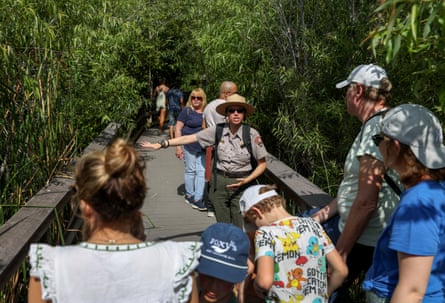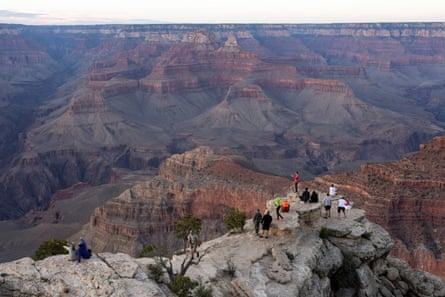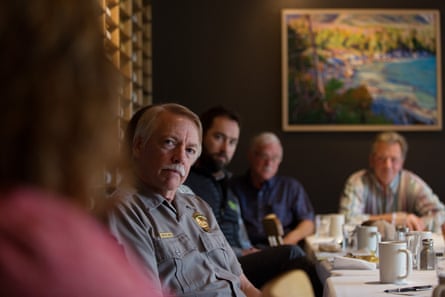
Throwing up his hands in disgust and abruptly resigning was not how Mark Nebel envisioned he would end his long career with the National Park Service. He loved his job at the Grand Canyon, where he had worked for 15 years.
As manager of the park’s geosciences program, Nebel, 68, oversaw efforts to protect its geology and paleontology as well as monitoring water sources, air quality and the effects of climate change. He had planned to stay in his position at least five more years before retiring. There was still much research to do to support the vulnerable ecosystems in one of the world’s greatest natural wonders.
But after Donald Trump took office, Nebel’s rewarding job turned into a bottomless pit of frustrations. As “department of government efficiency” (Doge) staff embedded themselves in the National Park Service on their hunt for “waste, fraud and abuse”, Nebel says his program – which works closely with universities, non-profits and Native American tribes – became hamstrung.
“They made it impossible to do agreements with outside organizations, uphold contracts, purchase the tools we needed or send samples out to a lab for analysis,” he says. “And we were supposed to stop talking about climate change.”
He and his staff were also experiencing constant emotional stress. So Nebel made the tough decision to retire early to protect his health. “It was incredibly difficult and heartbreaking,” he says. “But I was tired of being manipulated, humiliated and unable to do the work that I was hired to do for the American people.”
Famously described as “America’s best idea” by the writer Wallace Stegner, the US national park system encompasses 85m acres with units in all 50 states, ranging from crown jewels such as the Grand Canyon and Yellowstone to national battlefields and tiny historic sites. The system is almost universally beloved; a recent Pew survey found it was, at 76%, the most-approved-of federal agency. And it seems to only grow more popular, hosting a record 331 million visitors last year. It is also a reliable economic engine for rural communities across the country, generating billions of dollars in tourism spending.

But this summer, the mood inside the parks is bleak. Interviews with more than a dozen current and former National Park Service employees paint a picture of turmoil and fear – the result of unprecedented staff reductions, untenable new rules and proposed funding cuts to the tune of more than $1bn. Adding to this anxiety is a decision by the US interior secretary, Doug Burgum, to give Tyler Hassen, a former oil company executive working for Doge, broad administrative authority over the Department of Interior, which oversees the national park system.
When the Trump administration’s slash-and-burn approach to the federal government and the environment began to take shape last winter, park insiders held their breath. Now, they say, their worst fears are bearing fruit – threatening the agency’s ability to recover endangered species, monitor ecosystem health, protect air and water quality, uphold treaty obligations to Native American tribes, and study the impacts of climate change.
As peak tourist season looms on the horizon, Burgum has sought to reassure the public that everything will be running smoothly. In a recent Fox interview, he said that the staff cuts were merely “clearing out the barn” and that the agency was simply turning its focus toward “customer-facing” services.
But employees – many of whom asked to remain anonymous due to fear of losing their jobs – warn that the new regime is seeking to run these natural wonders the way a corporation might run an amusement park, attending to the superficial needs while ignoring the environment beyond visitor parking lots. Though toilets may sparkle and visitor centers are staffed, they say the integrity of the country’s 109-year-old national park system is being eroded, along with the agency’s legally mandated responsibility to protect park resources.
The National Parks Conservation Association estimates that 2,500 full-time National Park Service positions – 13% of the total staff – have been eliminated since January. In addition to firing 1,000 agency employees who had probationary status, staff reductions have come from deferred-resignation and voluntary-early-retirement programs that are generally geared toward more senior and management positions – people such as Nebel. And while a federal judge recently halted plans to cut an additional 1,500 positions this month, providing some temporary relief, chaos and a lack of leadership remains the norm.
Four months into Trump’s second term, the cracks are showing: a shortage of people working the entrance booths at the Grand Canyon prompted the park to allow visitors in for free during several busy days in February. And five of 10 campgrounds in the Great Smoky Mountains – the most heavily visited park in the system – are closed due to lack of staffing.
Meanwhile, over in Yosemite, more than half of the senior management positions remain vacant as a result of an agency-wide freeze on hiring permanent staff. A moratorium on seasonal hires that lasted for a month, before being abruptly lifted, caused Yosemite scientists to resort to cleaning public bathrooms because there was no one else to do it. Deep cuts at the agency’s Alaska regional office have left just one person to oversee archaeology and cultural resource protection for the state’s more than 50m acres of national park land. And more than 100 parks in the 433-unit system are currently without permanent superintendents.

In tandem with the cuts, employees say they have experienced a devaluing of their careers in government, describing a kind of “bullying” and “hazing” that is now part of the daily work atmosphere as the administration takes a cudgel to environmental and climate policies nationwide. Nebel and his staff, like all federal employees, received regular unsigned emails from the office of personnel management – taken over by Doge – that demeaned them for being public servants and pushed them to opt into a resignation program.
“We encourage you to find a job in the private sector,” stated one message. “The way to greater American prosperity is encouraging people to move from lower productivity jobs in the public sector to higher productivity jobs in the private sector.”
The Guardian contacted the Department of Interior for comment on the impact of recent staff reductions and other changes, but did not receive a response.
“The Trump administration says this is all about efficiency, but it is nothing of the sort,” says Nebel. “They are making our jobs harder, less efficient and preventing us from monitoring vital environmental systems.” A case in point: a $7m program funded primarily through the non-profit Grand Canyon Conservancy to monitor seeps and springs across the 2m-acre park is in limbo due to hiring and contract restrictions.
Many other scientific programs are on the chopping block, too. The New York Times reported earlier this month that Doge has earmarked $26m in park service grants for elimination this year, grants that support a variety of research conducted in partnership with universities, state historic preservation offices, tribes and youth corps. Scientists in Parks, which places students and early career scientists inside parks, is one of dozens of programs slated for removal.
Scientists such as Nebel are sounding the alarm about the dire environmental consequences that could result from these erratic and seemingly nonsensical cost-cutting measures and policy changes.
“Our ability to send people out into the field was temporarily shut down,” says a biologist who oversees an endangered species recovery program. “There is so much uncertainty about keeping our jobs, maintaining contracts and being allowed to work with other agencies that are going through their own staff reductions.”
She is also concerned about the Trump administration’s proposed rule change to the Endangered Species Act that would remove the law’s mandate for preserving critical habitats.
“If we are no longer able to do our jobs to protect the habitat in this park, we could quickly lose an entire species,” she says. “National parks are intended to be havens for native species. If we can’t maintain the ecosystem here, then I don’t see much hope for other places.”

Another senior supervisor at a large park says they have haemorrhaged full-time staff, leaving seasonal summer employees without the necessary support and managers. The supervisor says new edicts are handed down on a regular basis from Doge that directly affect her park’s operations, but are decided without any input from park management. In addition to the hiring freeze, new restrictions have included banning the use of agency credit cards for travel, requiring Doge approval for large purchases, canceling contracts and grants, and prohibiting anything that could fall under the ambiguous umbrella of DEI.
There is also the constant specter of employees losing their jobs simply because Doge deems them expendable. Many people interviewed for this story expressed another existential fear: given that employees often live in housing provided by the park service, a lost job can mean suddenly becoming homeless.
“I have spent a lot of time trying to calm our staff,” says the supervisor. “Every day you come to work and you have no idea what is going to happen next. It’s like we are all being subjected to psychological warfare.”
‘Heading towards facade management’
When the former national parks director Jonathan Jarvis surveys the current landscape, he is reminded of a trip to China he took more than two decades ago.
At the time, China was developing its first ever national park system and looked to the US as a shining example. Jarvis – who was then the superintendent of Alaska’s Wrangell-St Elias national park – found himself deep inside a cave that Chinese representatives wanted to show off. “I brought a flashlight,” he recalls, “so I could see what they weren’t showing me.”
While the environment of the main cavern had been restored to what appeared to be a healthy cave ecosystem, Jarvis’s flashlight beam revealed side caverns that were full of garbage. “They were taking all the human litter left by the visitors above ground and stuffing it below,” he says. “Their idea of a park was pure facade management.”
Jarvis, who spent more than three decades in the NPS before becoming its director under Barack Obama, sees a chilling lesson for today. While the Chinese government has since improved its land management policies and now has a national park system that embraces protecting the environment, Jarvis says the US is at risk of regressing under Trump to the crude approach taken by Beijing decades ago.
“We are headed toward facade management,” Jarvis says of the Doge-induced changes.
The Trump administration’s proposed funding cuts of more than $1bn for 2026, or nearly 25%, would be the largest in the agency’s 109-year history. Trump’s budget also seeks to transfer an unidentified number of national park sites over to states, in effect shrinking the park system – a move never before proposed by a US president.
Another casualty, according to park staff interviewed for this story, is the NPS’s relationship with Native American tribes. Under Biden, the NPS got its first ever Indigenous leader – Chuck Sams – and the agency was encouraged to consult tribes on park initiatives and highlight traditional ecological knowledge.

Now, the interior department is moving in the opposite direction. Programs focused on increasing diversity in the parks have been scrapped. The agency’s once robust tribal liaison program has been gutted, with regional and national offices that once employed several dozen staff members reduced to approximately five people in total, according an Indigenous liaison who recently resigned.
“What happened in the Biden administration was very positive,” says an Indigenous national park employee. “It seemed like the park service was moving into a new era of co-management with tribes, and encouraging reconnection to our homelands. But now everything has changed. Like all minorities, we have once again become second-class citizens.”
Yet, despite the emphasis on cost-cutting and rooting out waste, there is actually little excess at the chronically underfunded National Park Service. The agency has not received a significant budget increase in decades and it has a deferred maintenance backlog totaling more than $22m. According to statistics from the National Parks Conservation Association, the congressional appropriation for park operations in 2025 was about the same as it was in 2002. Full-time staff positions have decreased over the past decade as visitation soared to record heights.
And given that the parks are the economic lifeblood of many rural towns – bringing jobs and tourist dollars into the kinds of communities the Trump administration says it wants to support – the proposed cuts have left many park advocates scratching their heads.
“It’s unbelievable to me that the administration would target the National Park Service to prove their point on the federal budget,” says Kristen Brengel, senior vice-president of government affairs for the National Parks Conservation Association. “It just doesn’t compute.”
But Jarvis believes the assault is not really about the economy or government efficiency. Although the National Park Service experienced cost-cutting and other stresses during the first Trump administration, he fears this time there is a deliberate strategy to prevent national park employees from carrying out their mission to protect irreplaceable resources.
“There are ideologues who want to dismantle the federal government,” he says. “And the last thing they need is a highly popular federal agency that undermines their argument about how the government is dysfunctional.
“So their approach is to make the agency fail,” he adds. “This is their chance to kill the golden goose.”
Despite the grim outlook, park staff say they are not giving up without a fight. “What the Doge people do not understand is that this is not a job for us,” says an employee who has worked for the NPS for several decades. “It is a calling.”
She says that while Doge may have its strategy to “move fast and break things”, park employees are abiding by their own mantra: “Keep calm and ranger on.”

 3 months ago
130
3 months ago
130

















































